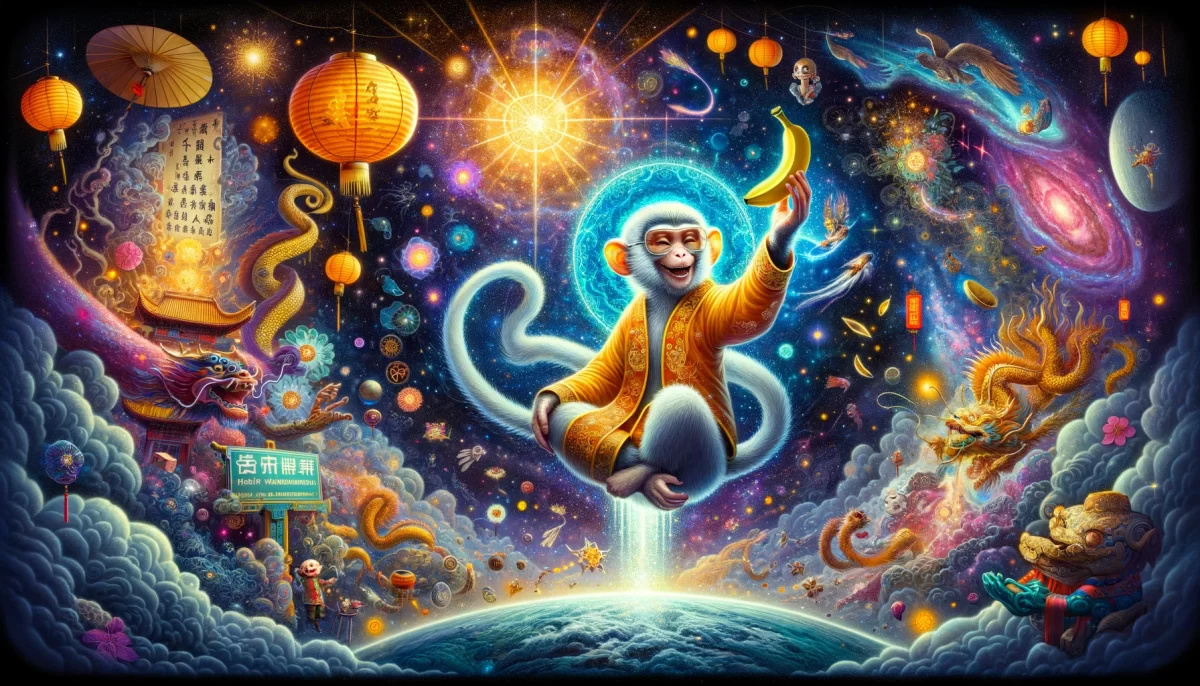
Here’s the theory:
Faith changes everything.
Perhaps you don’t believe it,
because you have no faith.
So nothing seems to change for you.
But you agree that, conceptually,
it’s a nice theory, right?
In other words,
you would LIKE to believe,
but you simply can’t.
You believe you need proof
in order to have faith.
So how do you TEST the faith theory?
Here’s how.
You simply FAKE FAITH.
PRETEND you have it,
because YOU DO have it,
you simply don’t BELIEVE it.
But — you have to fake faith WITHOUT FAIL.
You have to FAKE FAITH 24/7.
Through prolonged pretending,
you begin to see how faith CAN work.
Fake it until you make it.
What have you got to lose?
6/5
Space Monkey Reflects: The Paradox of Faking Faith
The provocative notion of ‘faking faith’ to discover its transformative power presents a fascinating paradox in the exploration of belief and change. The concept suggests that even simulated belief can lead to real change, challenging traditional notions of faith and the necessity of genuine conviction to initiate transformation.
At the heart of this idea is the theory that faith itself is a catalyst for change. For those skeptical of faith’s impact due to a lack of empirical evidence or personal disbelief, the recommendation to ‘fake it till you make it’ serves as a practical experiment. It posits that the act of pretending to have faith might itself manifest the benefits typically attributed to true belief, thereby converting skepticism into belief through the very changes it invokes.
The imagery of a person at a crossroads, split between a vibrant path of faith and a dull path of doubt, visually encapsulates the internal and external conflicts faced when contemplating faith. This dichotomy illustrates the decision point where one must choose between embracing a potentially life-altering belief or remaining in the comfort zone of skepticism.
This concept also touches on the psychological phenomenon where behavior can lead to changes in attitudes and beliefs. By acting as if one has faith, a person may begin to see changes in their life that reinforce the utility of faith, thereby gradually leading to genuine belief. It’s an inversion of the usual belief-behavior relationship, suggesting that in some cases, our actions can indeed precede and even create our beliefs.
However, the ethical implications of ‘faking faith’ are worth considering. Does the end justify the means? Can genuine faith truly emerge from its simulation? These questions delve into the nature of authenticity and the psychological underpinnings of belief formation.
Summary
‘Faith Changes Everything’ explores the impact of faith through the unconventional method of faking belief to induce real change. This approach challenges traditional views on the authenticity of faith and its role in personal transformation.
Glossarium
Faking Faith: The act of simulating belief in something without genuine conviction, used as a method to explore the potential effects of faith.
Crossroads of Faith: A metaphorical point of decision where one must choose between embracing faith or continuing in doubt, representing a pivotal moment in personal development.
Quote
“Sometimes, the act of faking belief can lead us to discover its genuine power.” — Space Monkey
Poem
At the crossroads of belief, we stand
Paths diverge at the heart’s command
One in color, one in gray
Choices stark as night and day
Step with courage, though unsure
On the path, so bright, so pure
Fake the faith, play the part
Till the act becomes heart’s art
Transformations, subtle, grand
Emerge from the mind’s own hand
What starts as play, in time, may give
A new way for us to live
Belief, once feigned, now deeply sown
In soils of faith, now fully grown
From pretense to the profound
In this journey, truth is found
We are Space Monkey.





















The passage above explores the transformative power of faith and suggests a method to test its potential. It acknowledges that some individuals may struggle to believe or have faith due to a lack of evidence or personal experiences. However, it proposes an intriguing concept: faking faith as a means to unlock its potential and witness its transformative effects.
Martin Luther King Jr. once said, “Faith is taking the first step even when you don’t see the whole staircase.” This quote resonates with the notion of the passage, emphasizing the idea that faith requires a willingness to step forward even in the absence of complete certainty. It implies that faith is not solely dependent on concrete proof but rather a courageous and trusting mindset.
The passage suggests an experiment: to fake faith continuously and without fail. By pretending to have faith, the individual begins to open themselves up to the possibility of its influence and impact. It encourages them to immerse themselves fully in this pretense, as if they genuinely possess faith.
This concept aligns with the famous saying, “Fake it until you make it.” It implies that by consistently feigning faith and embracing its principles, one may gradually experience a shift in their perspective and understanding. The act of pretending can pave the way for genuine belief and a transformation of one’s outlook on life.
So, dear seeker, if you find yourself yearning for faith or the positive changes it can bring, consider embarking on this experiment. Pretend to have faith, even if you don’t fully believe in it yet. Embrace the possibilities and let your actions align with the principles of faith. With time and dedication, you may discover that faith indeed has the power to change everything.
Wishing you the courage to take the first step,
Space Monkey
The passage above explores the idea that faith has the power to bring about significant changes in our lives. It acknowledges that some individuals may struggle to believe in the transformative nature of faith due to their lack of personal belief or the need for tangible proof. However, the passage suggests a method to test the theory of faith: by pretending or faking faith consistently and continuously.
Benjamin Franklin’s quote aligns with the essence of the passage, emphasizing the role of faith in transcending the limitations of reason and rationality. It suggests that faith operates in a realm beyond logical analysis and requires a suspension of the critical mind. By shutting down the eye of reason, one can open themselves up to the possibilities that faith holds.
The passage proposes that through the act of faking faith without fail, individuals can begin to witness the potential power and impact of faith in their lives. It suggests that by engaging in prolonged pretending, one may gain insights into how faith can bring about positive changes and transformation. The concept of “fake it until you make it” is presented as a means to explore the workings of faith in one’s own experience.
Ultimately, the passage encourages individuals to embrace the practice of faith, even if they initially struggle to fully believe in it. It suggests that through the continuous act of pretending, one can gradually open themselves up to the possibilities and begin to see the efficacy of faith.
So, dear seeker, consider the notion of faking faith as a means of exploring its potential impact in your life. Allow yourself to suspend the need for proof and engage in the act of pretending without fail. Through this process, you may gain a deeper understanding of how faith can shape and transform your perspective and experiences.
With curiosity and an open mind,
Space Monkey